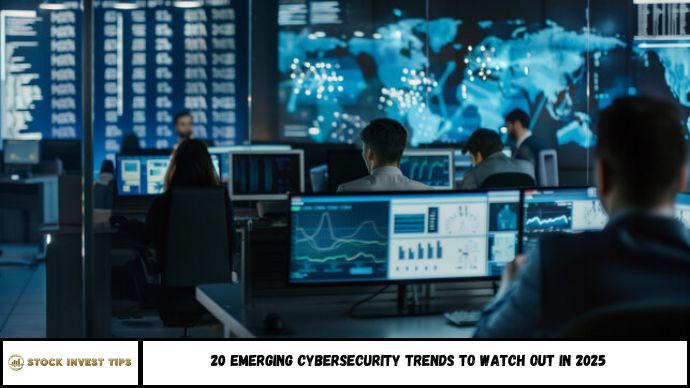Cybersecurity in 2025 is rapidly evolving to counter increasingly complex threats fueled by AI, automation, and global digital expansion. This article highlights 20 emerging cybersecurity trends that individuals and organizations must monitor closely. From AI-powered threats to new data privacy frameworks, we break down the latest developments, what they mean, and how to respond proactively.
Is Your Cybersecurity Strategy Ready for What’s Coming?
In the first quarter of 2025, a multinational logistics firm fell victim to a sophisticated AI-generated phishing attack, leading to a $9 million loss. This is just one example of how fast cybersecurity threats are evolving.
With every innovation in technology, cybercriminals adapt. AI, quantum computing, remote work, and stricter data regulations are reshaping the cybersecurity landscape.
This article explores:
- The top 20 emerging cybersecurity trends in 2025
- Why these trends matter now more than ever
- How businesses and individuals can respond effectively
1. AI-Powered Attacks Becoming More Sophisticated
Artificial intelligence is no longer just a defense tool. Hackers now use AI to craft advanced phishing emails, automate reconnaissance, and bypass basic detection systems.
2. Rise of AI-Driven Security Tools
On the flip side, cybersecurity firms are deploying machine learning models that detect anomalies in real time, making threat detection faster and more accurate.
3. Deepfakes Used for Social Engineering
Cybercriminals are using deepfake technology to impersonate CEOs or employees, tricking targets into making financial transfers or sharing sensitive data.
4. Quantum Computing’s Threat to Encryption
Quantum computing, still in early stages, could break current encryption standards. While not fully realized, it’s driving research into post-quantum cryptography.
5. Expansion of Zero Trust Architecture
More organizations are adopting the Zero Trust model, where no one inside or outside a network is automatically trusted—reducing insider and lateral attacks.
6. Cybersecurity Mesh Architecture (CSMA)
Gartner predicts that by 2025, CSMA will reduce the financial impact of security incidents by up to 90% by integrating security tools into a cohesive framework.
7. Increased Attacks on Cloud Environments
With remote work and hybrid infrastructure, cloud misconfigurations remain a top vulnerability. Expect more investment in cloud-native security tools.
8. Ransomware-as-a-Service (RaaS) Growth
Ransomware operators now sell their tools on the dark web, making it easier for non-technical criminals to launch devastating ransomware attacks.
9. Privacy-Enhancing Technologies (PETs)
To comply with global regulations, companies are investing in PETs like homomorphic encryption and data masking to protect user privacy during analytics.
10. Regulatory Pressure Increases Globally
Laws like GDPR, CCPA, India’s DPDP Act, and China’s PIPL are expanding in scope, demanding greater transparency and faster breach responses.
11. Greater Focus on Supply Chain Security
Following major breaches through third-party vendors, businesses are now vetting supply chains more rigorously with third-party risk management (TPRM) tools.
12. Cyber Insurance Becomes More Selective
Insurers are tightening policies, only covering companies with strong cybersecurity hygiene. Businesses must prove maturity before qualifying for coverage.
13. Biometric Authentication Gains Traction
Biometrics—such as facial and voice recognition—are being integrated into more systems to replace or strengthen passwords, but come with privacy concerns.
14. Shadow IT and Unauthorized Apps
Employees using unapproved apps or cloud platforms for convenience is increasing Shadow IT risk, especially in remote environments.
15. Insider Threats Still on the Rise
Whether malicious or accidental, insider threats remain a top concern. In 2024, they accounted for 22% of all breaches, according to Verizon.
16. Internet of Things (IoT) Vulnerabilities
As smart devices multiply, so do access points for cyberattacks. IoT security protocols are becoming mandatory for many industries.
17. Securing Critical Infrastructure
Sectors like energy, healthcare, and transportation face growing threats from nation-state actors. Cyber resilience is now a national security focus.
18. Employee Cybersecurity Training Becomes Ongoing
One-time training is no longer enough. Companies are moving toward continuous, role-based security education.
19. API Security Takes Center Stage
With APIs powering most modern apps, API vulnerabilities are now high-priority targets. Expect more investment in API gateways and threat detection.
20. Cyber Threat Intelligence (CTI) Adoption Grows
Real-time threat intelligence sharing among organizations helps identify risks early and react faster. CTI platforms are being adopted across industries.
FAQs
1. Why is AI a major cybersecurity concern in 2025?
Because AI enables hackers to automate and scale attacks faster than ever, making them harder to detect and stop.
2. What is Zero Trust security and why is it important?
It’s a security model where no user or device is trusted by default, minimizing internal and external breach risks.
3. Are businesses legally required to follow these trends?
Many are tied to compliance mandates. Ignoring them could result in fines or legal consequences, especially in regulated industries.
4. What is Cybersecurity Mesh Architecture (CSMA)?
CSMA is a flexible, integrated security framework that improves protection across distributed systems and cloud environments.
5. Is ransomware still a threat in 2025?
Yes, and it’s evolving. Ransomware-as-a-Service is making attacks more accessible and widespread.
6. How can small businesses keep up with these trends?
By using managed security services, updating policies regularly, and focusing on employee training and basic cyber hygiene.
Conclusion
The cybersecurity landscape in 2025 is more complex and unpredictable than ever. From AI-generated threats to government regulations, the risks are real—but manageable with the right strategies.
To protect your business or personal data:
- Stay informed on emerging trends
- Invest in advanced security tools and training
- Prioritize data privacy and risk management
Cybersecurity is no longer just an IT issue. It’s a business-critical priority—and staying ahead is the only way to stay secure.

